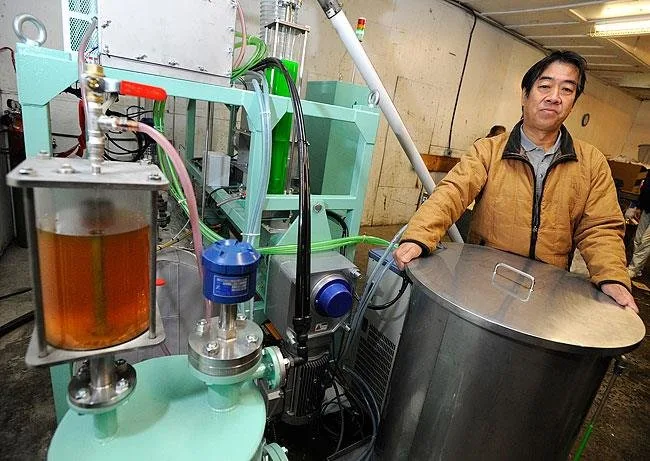Japanese Inventor Developed a Machine That Transforms Plastic Into Fuel
In a world drowning in plastic waste and scrambling for sustainable energy, a Japanese inventor has engineered a small but powerful solution that could shake up both industries. Akinori Ito, an environmental entrepreneur, has developed a machine capable of converting plastic waste into fuel—a compact, household-sized device that uses thermal decomposition to transform trash into crude oil.

While the basic science behind this—pyrolysis—is well established, Ito’s application makes it accessible, safe, and efficient for public and small-scale use. In a country known for technological innovation and meticulous design, Ito’s invention is gaining attention not just as a gadget, but as a model for practical sustainability.
How It Works
The machine functions through a closed-system pyrolysis process. After the plastic (excluding PET bottles) is shredded into small flakes, it’s heated to approximately 427°C (800°F) in an oxygen-free chamber. Instead of combusting, the plastic decomposes into gas, which is then cooled and condensed into a usable oil.
Each cycle of the machine can process around 1 kilogram of plastic, yielding nearly 1 liter of crude oil. That oil can then be refined into fuels like gasoline, diesel, or kerosene—or used directly in generators or burners. Remarkably, the machine’s design emphasizes simplicity and safety, making it suitable for educational, municipal, and even household use.
Environmental Impact
Ito’s invention lands at the intersection of multiple global concerns: waste management, carbon emissions, and energy production. It offers an alternative to traditional methods of plastic disposal, which typically involve landfill burial or incineration—both of which come with long-term environmental costs.
By preventing plastics from reaching oceans and landfills and converting them into fuel in a clean, low-emission process, the device directly contributes to a circular economy. Its oxygen-free environment avoids the toxic byproducts associated with incineration. Furthermore, the oil output displaces fossil fuels that would otherwise be extracted and burned, reducing overall emissions.
Economic Potential
The economic implications are as compelling as the environmental benefits. For municipalities, reducing landfill use and incineration means lower waste management costs. For businesses, especially in regions with limited fuel infrastructure, the device opens up an alternative supply chain for energy.
Crucially, the machine also allows communities to create self-sustaining micro-economies. Waste becomes a resource; managing it becomes a job creator. From collection and sorting to machine operation and oil refinement, each phase of the process creates local employment opportunities.
In remote or energy-scarce areas—particularly islands or disaster-struck regions—this technology offers immediate relief by converting debris into fuel for electricity or heating. Its portability and ease of use further amplify its utility in crisis response scenarios.
Broader Applications
Ito’s device is already being piloted in schools, where it doubles as a hands-on educational tool in science and sustainability programs. Small businesses, especially in food service and retail sectors, are eyeing it as a way to offset operational costs and enhance green branding. In agriculture, it presents a compelling opportunity to produce fuel on-site for use in equipment or heating.
Some companies are also looking to incorporate the device into broader waste processing systems, potentially creating closed-loop cycles where fuel generated from waste powers the recycling plant itself.
Challenges Ahead
Despite its promise, Ito’s invention faces significant hurdles. Scaling the technology for industrial use involves complex logistics and engineering. The machine’s small size, while ideal for localized use, limits its throughput for high-density urban areas unless deployed in large numbers.
Furthermore, the process requires relatively clean and sorted plastic. Regions without established recycling infrastructures will need to develop effective collection and preprocessing systems to make deployment viable.
There are also regulatory obstacles. In many jurisdictions, energy production and waste processing are heavily regulated, and pyrolysis technology remains under legal scrutiny due to its novel classification. Updating legislation to accommodate this hybrid recycling-energy model is a necessary step toward broader adoption.
A Glimpse Into the Future
Ito’s plastic-to-fuel machine doesn’t just offer a new way to recycle—it redefines what recycling can be. It challenges the global “take-make-waste” industrial model and offers a compelling alternative: turn waste into a renewable resource.
It’s not just a piece of equipment—it’s a symbol. A symbol of what happens when engineering meets environmental urgency. Akinori Ito’s invention shows that small-scale innovation can spark global change, especially when it offers practical, replicable solutions for real-world problems.
The machine is already being used in parts of Asia and Europe, and interest is growing in Africa and Latin America. With proper policy support, economic incentives, and further technical refinements, Ito’s idea could reshape how the world thinks about plastic—and energy.
At a time when ecological despair often overshadows progress, this Japanese innovation delivers a rare and powerful message: the problem is the solution.